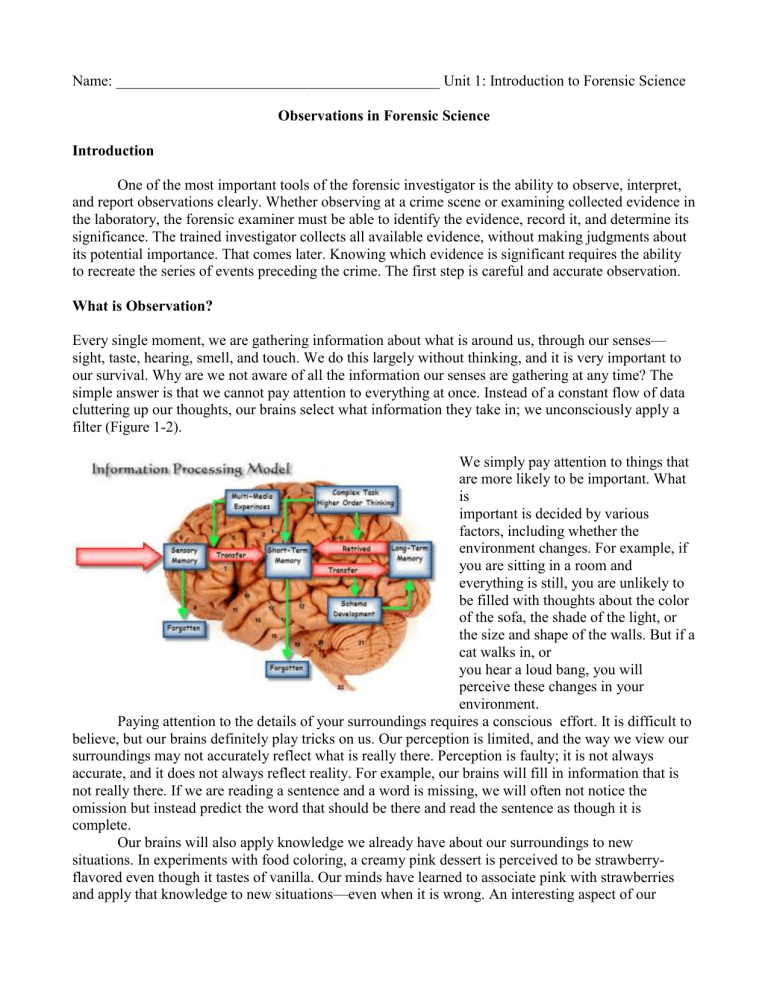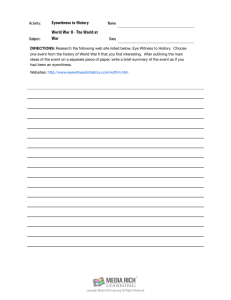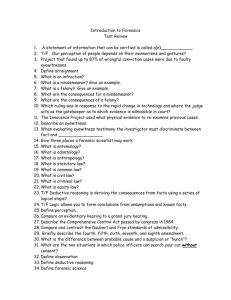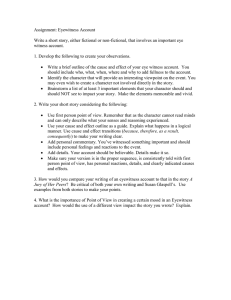
Name: ___________________________________________ Unit 1: Introduction to Forensic Science Observations in Forensic Science Introduction One of the most important tools of the forensic investigator is the ability to observe, interpret, and report observations clearly. Whether observing at a crime scene or examining collected evidence in the laboratory, the forensic examiner must be able to identify the evidence, record it, and determine its significance. The trained investigator collects all available evidence, without making judgments about its potential importance. That comes later. Knowing which evidence is significant requires the ability to recreate the series of events preceding the crime. The first step is careful and accurate observation. What is Observation? Every single moment, we are gathering information about what is around us, through our senses— sight, taste, hearing, smell, and touch. We do this largely without thinking, and it is very important to our survival. Why are we not aware of all the information our senses are gathering at any time? The simple answer is that we cannot pay attention to everything at once. Instead of a constant flow of data cluttering up our thoughts, our brains select what information they take in; we unconsciously apply a filter (Figure 1-2). We simply pay attention to things that are more likely to be important. What is important is decided by various factors, including whether the environment changes. For example, if you are sitting in a room and everything is still, you are unlikely to be filled with thoughts about the color of the sofa, the shade of the light, or the size and shape of the walls. But if a cat walks in, or you hear a loud bang, you will perceive these changes in your environment. Paying attention to the details of your surroundings requires a conscious effort. It is difficult to believe, but our brains definitely play tricks on us. Our perception is limited, and the way we view our surroundings may not accurately reflect what is really there. Perception is faulty; it is not always accurate, and it does not always reflect reality. For example, our brains will fill in information that is not really there. If we are reading a sentence and a word is missing, we will often not notice the omission but instead predict the word that should be there and read the sentence as though it is complete. Our brains will also apply knowledge we already have about our surroundings to new situations. In experiments with food coloring, a creamy pink dessert is perceived to be strawberryflavored even though it tastes of vanilla. Our minds have learned to associate pink with strawberries and apply that knowledge to new situations—even when it is wrong. An interesting aspect of our perception is that we believe what we see and hear, even though our ability to be accurate is flawed. People will stick to what they think they saw, even after they have been shown that it is impossible. If you are feeling like your brain is rather defective, do not worry: the brain, while faulty, is still good at providing us with the information we need to survive. Filtering information, filling in gaps, and applying previous knowledge to new situations are all useful traits, even if they do interfere sometimes. Understanding our limitations helps us improve our observation skills, which is extremely important in forensic science. Criminal investigations depend on the observation skills of all parties involved—the police investigators, the forensic scientists, and the witnesses. Did you Know? China, 1248: The suspect in a stabbing death confessed after flies were used to determine which knife in the village had blood on it. All of the knives of the village were collected, and when the flies all landed on just one knife, the man confessed. Observations by Witnesses One key component of any crime investigation is the observations made by witnesses. Not surprisingly, the perceptions of witnesses can be faulty, even though a witness may be utterly convinced of what he or she saw. Have you ever noticed that you can walk along the street or ride in a car and be totally unaware of your surroundings? You may be deeply involved in a serious conversation or hear some disturbing news and lose track of events happening around you. Your focus and concentration may make an accurate accounting of events difficult. Our emotional state influences our ability to see and hear what is happening around us. If people are very upset, happy, or depressed, they are more likely not to notice their surroundings. Anxiety also plays a big part in what we see and what we can remember. Our fear at a stressful time may interfere with an accurate memory. Victims of bank robberies often relate conflicting descriptions of the circumstances surrounding the robbery. Their descriptions of the criminals committing the robbery often do not match (Figure 1-3). In an unusual situation, however, our ability to observe is often heightened. For example, most people can recall exactly where they were when they first heard of the attack on the World Trade Center towers in Manhattan on September 11, 2001. Other factors affecting our observational skills include: • Whether you are alone or with a group of people • The number of people and/or animals in the area • What type of activity is going on around you • How much activity is occurring around you All of these factors influence the accuracy of a witness’s observations. Eyewitness Accounts What we perceive about a person depends, in part, on his or her mannerisms and gestures. How a person looks, walks, stands, and uses hand gestures all contribute to our picture of his or her appearance. Think about your family members. How would you describe them? What makes them unique? We also form images of familiar places. Our homes, school, and other places we might often visit (e.g., a favorite store or restaurant) are burned into our memories and easy to recognize and remember. Eyewitness accounts of crime-scene events vary considerably from one person to another. What you observe depends on your level of interest, stress, concentration, and the amount and kind of distraction that may be present. Our prejudices, personal beliefs, and motives also affect what we see. Memory fades with time, and our brains tend to fill in details that we feel are appropriate but may not be accurate. These factors can decrease an eyewitness’s reliability in reporting a crime. The testimony of an eyewitness can be very powerful in persuading the jury one way or another; knowing the shortcomings of eyewitness testimony is necessary to ensure that justice is carried out appropriately. The Innocence Project The Innocence Project at the Benjamin N. Cardozo School of Law at Yeshiva University in New York was created by Barry C. Scheck and Peter J. Neufeld in 1992. Its purpose was to reexamine postconviction cases (individuals convicted and in prison) using DNA evidence to provide conclusive proof of guilt or innocence (Figure 1-4). After evaluating more than 200 wrongful convictions in the United States, the Innocence Project found that faulty eyewitness identification contributed up to 87 percent of those wrongful convictions. Eyewitness errors included mistakes in describing the age, and facial distinctiveness of the suspect. These mistakes resulted from disguised appearances, brief sightings of the perpetrator, cross-gender and cross-racial bias, and changes in the viewing environment (from crime scene to police lineup). When evaluating eyewitness testimony, the investigator must discriminate between fact and opinion. What did the witness actually see? Often what we think we see and what really happened may differ. The act of someone fleeing from the site of a shooting might imply guilt but could also be an innocent bystander running away in fear of being shot. Witnesses have to be carefully examined to describe what they saw (eyewitness evidence), not what they thought happened (opinion). On completion of witness examination, the examiner tries to piece together the events (facts) preceding the crime into a logical pattern. The next step is to determine if this pattern of events is verified by the evidence and reinforced by the witness testimony. How to Be A Good Observer We can apply what we know about how the brain processes information to improve our observation skills. Here are some basic tips: 1. We know that we are not naturally inclined to pay attention to all of the details of our surroundings. To be a good observer, we must make a conscious effort to examine our environment systematically. For example, if you are at a crime scene, you could start at one corner of the room and run your eyes slowly over every space, looking at everything you see. Likewise, when examining a piece of evidence on a microscope slide, look systematically at every part of the evidence. 2. We know that we are naturally inclined to filter out unimportant information. However, at a crime scene, we do not know what may turn out to be important. In this situation, we can consciously decide to observe everything, no matter how small or how familiar, no matter what our emotions or previous experiences. So we train ourselves to turn off our filters, and instead act more like data-gathering robots. 3. We know that we are naturally inclined to interpret what we see, to look for patterns, and make connections. To some degree, this inclination can lead to us jumping to conclusions. While observing, we need to be careful that we concentrate first and foremost on gathering all of the available information and leaving the interpretation until we have as much information as possible. The more information we have, the better our interpretations will be. That does not mean that we should not think about what we see. If we analyze what an observation might mean at the time, we may be led to look more closely for further evidence. 4. We know that our memories are faulty. While observing, it is important to write down and photograph as much information as possible (Figure 1-5). This will become very important later when we, or our investigating team members, are using our observations to try to piece together a crime. Documentation also is important when acting as an expert witness. A judge will only accept hair evidence that has been documented in writing and with photographs taken at the crime scene. The verbal testimony of a forensic scientist alone may not be entered into evidence without the proper documentation.


